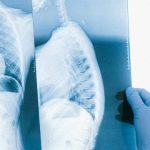Can Depression Cause Neurological Problems? | Sai Hospital, Haldwani

Fibrosis of the lungs — also known as pulmonary fibrosis — is a condition where the lung tissue becomes thick, stiff, and scarred over time. This scarring makes it harder for the lungs to expand and for oxygen to move into the bloodstream. Patients often first notice breathlessness, dry cough, or fatigue, but the underlying damage usually begins long before symptoms appear.
At Sai Hospital, Haldwani, our pulmonologists regularly diagnose and manage lung fibrosis, helping patients understand the cause, control symptoms, and slow the condition’s progression. This detailed guide explains what causes fibrosis of the lungs, who is at risk, and what early signs should not be ignored.
What Is Lung Fibrosis?
Lung fibrosis refers to scarring of lung tissue, particularly the interstitium — the thin, delicate lining between the air sacs. When this tissue becomes scarred, the lungs become less flexible and cannot transfer oxygen efficiently.
Fibrosis can be idiopathic (cause unknown) or due to identifiable triggers such as infections, long-term inflammation, environmental exposure, medications, or autoimmune diseases.
What Causes Fibrosis of the Lungs?
There is no single cause. Lung fibrosis can develop due to several factors, and sometimes multiple causes overlap. Below are the most important contributors.
1. Idiopathic Pulmonary Fibrosis (IPF)
This is the most common type of lung fibrosis, and sadly, the cause is still unknown.
“Idiopathic” means doctors cannot identify a specific reason.
However, contributing factors may include:
- Aging
- Genetic predisposition
- Abnormal healing response to micro-injuries
- Smoking history
- Viral infections
- Environmental irritants
IPF mainly affects adults over 50 and progresses gradually.
2. Long-Term Occupational and Environmental Exposure
Repeated inhalation of harmful particles can irritate and damage lung tissue over time.
Common culprits include:
- Silica dust (stone cutting, mining)
- Asbestos fibers
- Coal dust
- Metal fumes
- Grain dust
- Mold exposure
- Chemical fumes in factories
Workers in construction, textile, carpentry, welding, mining, and agriculture are particularly at risk.
This category includes diseases like:
- Asbestosis
- Silicosis
- Coal worker’s pneumoconiosis
3. Autoimmune and Connective Tissue Disorders
Several autoimmune diseases can attack the lungs, causing inflammation that eventually leads to scarring.
These include:
- Rheumatoid arthritis
- Systemic lupus erythematosus (SLE)
- Scleroderma
- Polymyositis and dermatomyositis
- Sjögren’s syndrome
When the immune system mistakenly attacks lung tissue, fibrosis may develop gradually.
4. Chronic Lung Inflammation
Chronic infections or inflammatory lung diseases can damage the interstitium.
Examples include:
- Recurrent respiratory infections
- Chronic hypersensitivity pneumonitis
- Sarcoidosis
- Long-standing pneumonia
- Untreated allergic lung conditions
If inflammation continues, the healing response forms scar tissue instead of normal lung tissue.
5. Certain Medications
Some medicines, especially when taken long-term or in high doses, can cause lung scarring.
Common medication-related causes:
- Chemotherapy drugs (bleomycin, methotrexate)
- Amiodarone (used for heart rhythm problems)
- Nitrofurantoin (antibiotic for UTIs)
- Radiation therapy for breast or lung cancer
Doctors monitor lung function closely in patients using these drugs.
6. Smoking and Tobacco Exposure
Smoking is one of the strongest risk factors for developing lung fibrosis.
It damages the air sacs, weakens lung immunity, and triggers abnormal healing responses. Even passive smoking increases the risk.
7. Viral Infections
Certain viral infections can damage lung tissue and lead to fibrosis, especially if the inflammation is severe or long-lasting.
Examples:
- Post-COVID fibrosis
- Viral pneumonia
- Influenza complications
COVID-19 has been a major contributor to new fibrosis cases worldwide due to severe lung inflammation in some patients.
8. Genetic Factors
In some families, fibrosis runs in the genes.
Genetic abnormalities can affect how lung tissue repairs itself, causing scar formation even after minor injuries.
Conditions like familial pulmonary fibrosis are well-recognized.
9. Gastroesophageal Reflux Disease (GERD)
Repeated micro-aspiration of stomach acid into the lungs — often unnoticed — can irritate lung tissue and contribute to scarring. This is more common in people with severe or uncontrolled reflux disease.
10. Aging
As people age, lung tissue becomes more vulnerable to injury.
Older adults also have slower tissue repair, making them more prone to fibrosis even with mild irritants.
Early Symptoms of Lung Fibrosis
Many patients ignore early signs, assuming it’s just aging or reduced stamina.
But early detection makes a significant difference.
Watch for the following symptoms:
- Shortness of breath, even during mild activity
- Persistent dry cough
- Fatigue or weakness
- Unexplained weight loss
- Chest discomfort
- “Velcro crackles” (crackling sound when breathing)
- Clubbing of fingers (in advanced stages)
If you notice these for more than a few weeks, a lung evaluation is important.
How Is Lung Fibrosis Diagnosed?
At Sai Hospital, Haldwani, pulmonologists use a combination of tests:
- High-resolution CT (HRCT) scan
- Pulmonary function tests (PFTs)
- Blood tests for autoimmune markers
- 6-minute walk test
- In some cases, lung biopsy or bronchoscopy
Accurate diagnosis helps identify the cause and guide treatment.
Is Lung Fibrosis Curable?
Lung fibrosis cannot be completely reversed because scar tissue does not turn back into normal lung tissue.
However, early diagnosis and treatment slow the progression, reduce symptoms, and improve quality of life.
Treatment may include:
- Antifibrotic medications (pirfenidone, nintedanib)
- Steroids or immunosuppressants
- Oxygen therapy
- Pulmonary rehabilitation
- Lifestyle changes, including quitting smoking
- Treating underlying autoimmune or infectious causes
FAQs: What Causes Fibrosis of the Lungs
1. Can lung fibrosis be caused by COVID-19?
Yes. Severe COVID-19 pneumonia can lead to scarring in some patients.
2. Can smoking alone cause lung fibrosis?
Yes. Smoking damages lung tissue and significantly increases fibrosis risk.
3. Is fibrosis hereditary?
In some families, genetic mutations can cause inherited pulmonary fibrosis.
4. Does dust exposure cause fibrosis?
Long-term exposure to silica, asbestos, or coal dust is a common cause.
5. Can fibrosis be stopped from worsening?
With early diagnosis, medications and lifestyle changes can slow progression.
Conclusion
So, what causes fibrosis of the lungs?
The reasons range from autoimmune diseases to environmental exposures, medication effects, chronic inflammation, infections, smoking, and even unknown causes like idiopathic pulmonary fibrosis.
At Sai Hospital, Haldwani, our pulmonologists focus on early detection, personalized treatment, and long-term management to help patients breathe better and live healthier lives.
If you or someone you know is experiencing persistent breathlessness or chronic cough, don’t ignore it — early evaluation can prevent long-term damage.



